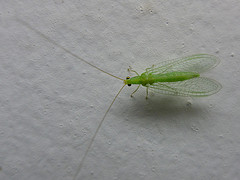This is most likely a lacewing larvae insect which believe it or not they can be extremely beneficial to the garden. They eat all sorts of small things that are creeping and crawling around in your garden including thrips, red spider mites, small caterpillar eggs and mealy bugs.
The larvae can be introduced in fruit and vegetable crops or even in ornamental plants. The larvae are pretty tiny, measuring approximately just 0.8 mm. They are extremely adapt at combating aphid infestations, each insect is capable of consuming up to 50 aphids per day. If you would like to use the insects to combact your aphid problem, follow these steps:
As the larvae cannot fly, they need to be able to reach their prey and hence the larvae should therefore be placed near the aphids. The larvae are able to move a great distance for something so small, amassing up 4-5 km before they even grow into fully fledged adults. The adult lacewing lays approximately 20 eggs every day with the time it takes to get from egg to adult takes about 30 days normally.
Ants protect aphids, and fight with the lacewings. Lacewings are common, capable of flight and measure around 12 - 15 mm with green bodies and delicate green lacy wings which lie folded on their back when they are stationary.
The adult's diet mainly consists of honey, pollen, and nectar, which they need to reproduce. They are known as the 'aphid lion' and as a single insect can consume 100-600 aphids in its lifetime. Adults tend to hibernate over winter, and mate during the summer months.
The first larvae to emerge are brown in appearance and about 4mm long, with sharp nipping claws at the front whereas the more mature older larvae are paler, about 13 mm long, with bristles on their back.
The larvae can be introduced in fruit and vegetable crops or even in ornamental plants. The larvae are pretty tiny, measuring approximately just 0.8 mm. They are extremely adapt at combating aphid infestations, each insect is capable of consuming up to 50 aphids per day. If you would like to use the insects to combact your aphid problem, follow these steps:
As the larvae cannot fly, they need to be able to reach their prey and hence the larvae should therefore be placed near the aphids. The larvae are able to move a great distance for something so small, amassing up 4-5 km before they even grow into fully fledged adults. The adult lacewing lays approximately 20 eggs every day with the time it takes to get from egg to adult takes about 30 days normally.
Ants protect aphids, and fight with the lacewings. Lacewings are common, capable of flight and measure around 12 - 15 mm with green bodies and delicate green lacy wings which lie folded on their back when they are stationary.
The adult's diet mainly consists of honey, pollen, and nectar, which they need to reproduce. They are known as the 'aphid lion' and as a single insect can consume 100-600 aphids in its lifetime. Adults tend to hibernate over winter, and mate during the summer months.
The first larvae to emerge are brown in appearance and about 4mm long, with sharp nipping claws at the front whereas the more mature older larvae are paler, about 13 mm long, with bristles on their back.

